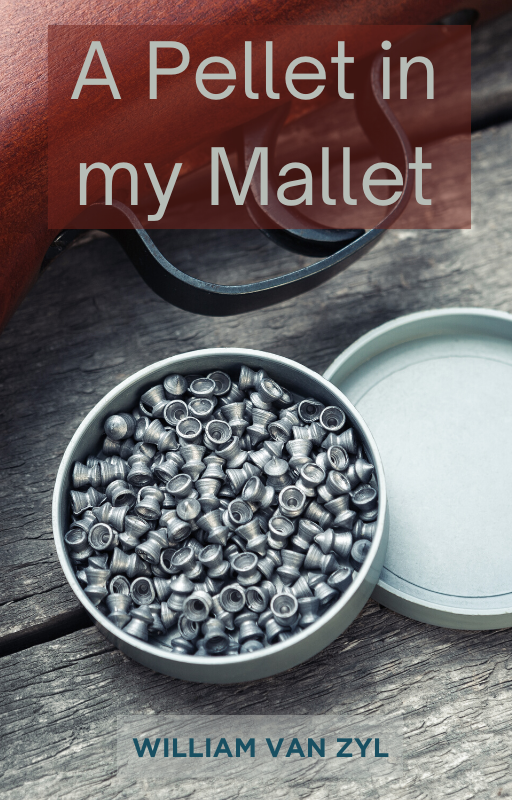
By William Van Zyl
Published in June 2023
‘Whizz – plink – swoosh – whirr!’
That sound? Imagine target shooting with an air rifle. A pellet strikes one of the small metal levers hanging from a wire frame. Because the lever is lightweight, it spins round and round when the projectile hits the lever. Then, eventually, it stops spinning and comes to a halt. Ready to be hit again. So much fun.
Do you know that plinking sounds as air rifle pellets hit the targets in your backyard? Have you seen washing pegs spin on a washing line and then disintegrate? The plonk as a soft drink can’s belly open and topple off a loose brick? The shatter of glass as a lead pellet strikes a small glass jar. At a short distance, it fully disintegrates. Do you know the adrenaline rush when a bird suddenly swoops in and sits on the washing line?
Have you ever maintained the black gunmetal barrel and fine-grained wooden stock of an air rifle with a small 2 x 4 oil rag? The satisfaction of running a ramrod down the barrel with brass brushes, followed by a tiny soft cloth and several oily rags that lubricate the pellet rifle’s shiny inside. Very rewarding!
Have you heard the clear click, click, click as you adjust the screws of the telescope up and down. Then, the second set of clicks – left or right? The thrill is to make the grouping perfect on the target – it is an art. A tight group is so satisfying!
By now, you could be thinking, what is the title’s meaning of this article? A Pellet in my Mallet? I have three answers: I wanted a catchy title and a little rhyme. I also imagined a wooden mallet lying next to a shooting target, the giant cardboard target attached to two large wooden stakes driven into the ground by the wooden mallet. Lastly, see the video below of Jer Schmidt. He experiments with creating a dead-blow wooden mallet that does not ‘jump’ when it hits a table (or anything else like a carpenter’s chisel). Could one replace the BB gun pellets – in Jer’s Mallet – with lead air rifle pellets? I am thinking – yes, it could work! In the comments below Jer’s video, a person recommended filling the mallet with iron sand. It shows the power of collaboration online. New creative and innovative ideas are developed when people discuss matters, concepts, experiments, and more. So, the title Pellet in My Mallet is a ‘dead blow’ to the reader. It stops the reader in their tracks. It prompts the reader to reflect on air rifles.
Pellets in a Mallet. Video: https://youtu.be/NT8MbxaqK00
An air rifle can be a building block – an exciting foundation – for bringing up a youngster. On the other side of the pellet, it can also be very detrimental. A lack of education and guidance can negatively shape and mould a young person’s attitudes, values, and character. It is an art to instil balanced manliness and womanliness, good character, deep values, a sustainable mindset, respect for life, respect for others, and the environment.
The adventure, the exploration, the thrill, the power, and the ‘thud’ of the pellet against the catcher will cultivate confidence in a young boy or girl.
Have you seen a lead pellet flattened against a heavy metal plate? It is a beautiful thing. The well-formed air rifle pellet shape – when it hits the metal plate – turns into a flat circular disc with slightly flared edges. Wonderful to hold in the palm of your hand.
Seeing the crosshairs of a telescope elicits the idea of being a sniper in a war movie for me. I have included some of my favourite scenes.
Table of Contents
Scenes from the movie Saving Private Ryan:
My ultimate sniper scene is from the movie Saving Private Ryan.
Video: https://youtu.be/wgHRj2-vvs8
The American sniper sits in the Church tower, defending and protecting his mates. As a German tank and some infantry soldiers approach, he recites verses from Psalm 144. See the recitation about 2 min and 42 seconds into the video below – stunning war scenery.
Psalm 144: 1 & 2 – Blessed be the Lord my strength which teacheth my hands to war, and my fingers to fight:
2 My goodness, and my fortress; my high tower, and my deliverer; my shield, and he in whom I trust; who subdueth my people under me.
It reminds me of David in the Bible – who slayed Goliath – he refers to Goliath as an uncircumcised Philistine, which means a person with no covenant with God.
“Who is this uncircumcised Philistine that he should defy the armies of the living God?” asked David when he saw the giant challenging the armies of Israel.
Scenes from American Sniper:
It also reminds me of the scenes in the movie American Sniper. American Sniper is a 2014 American biographical war drama directed by Clint Eastwood and written by Jason Hall. It is loosely based on the memoir American Sniper: The Autobiography of the Most Lethal Sniper in U.S. Military History (2012) by Chris Kyle, with Scott McEwen and Jim DeFelice. Please note I disapprove of the foul language used in the movie.
Longest sniper shots ever (all rifles)
I include a fascinating fact here about the longest successful sniper shot ever. Carlos Hathcock is the most legendary sniper in history for engaging and killing an enemy soldier in 1967 during the War in Vietnam. His shot from 2,500 yards (2286 meters) away was the longest-standing confirmed kill in sniper history for over three decades. That is over 2 km. Run a test; take your car, motorbike or bicycle and measure 2.2 km. Then place a marker down at one end and stand at the other end. If you have a rifle with a scope or binoculars, compare the distance with the scope or- binoculars and then look at the marker with the naked eye. It is a very, very long way. We know that a projectile – when fired – will drop significantly (weight of the round and gravity). The wind can also play a role. Could the Earth’s curve have an impact? It could the projectile drift left or right? For a 2.2 km shot, you have to aim far above the target.
It appears the unnamed sniper, a male, isn’t Canada’s only great marksman. Three of the top five most extended confirmed kill shots were conducted by a member of the Canadian military. (The other two were by a Brit and an American). Source: https://www.vox.com/world/2017/6/25/15863472/canada-sniper-record-two-miles-isis-iraq
The most commonly used shooting technique for muzzleloaders is the B.R.A.S.S. technique. It stands for:
Control your Breathing (I prefer breathing out slowly out when I squeeze the trigger)
Make sure you Relax
Hold your Aim (fixed support under the rifle is best)
Squeeze the trigger (don’t pull it)
Squeeze more (for follow-through – keep slow, steady pressure on the trigger until it fires)
The longest air rifle shot in history.
The longest successful shot with a pellet gun is 1400 yards (1280.16 meters). Airgun World Record belongs to the Altaros M24 brand – See the video on YouTube. If you watch the video, you will see that the target is almost invisible through the scope.
Link to video: https://youtu.be/B5ioDdftZIM
Details of the world record air rifle shot.
EQUIPMENT:
Air Rifle: Altaros M24 .22 Custom
Barrel: 26,5” Kuna 1:9 Twist
Optic: SWFA 20×42
Ammunitions: Altaros bullets .22 BT 61 grain
Bipod: TACTICAL EVO TK3
Ballistic Calculators: Applied Ballistics Analytics
Special Equipment: MOA booster set to + 170mRad ( almost 10 degrees )
The target was a chain wall 22×18″ (558.8 mm x 457.2 mm)
Comment: The beginnings of airgun LR shooting in our Altaros team date back to autumn 2018 when we first broke the 400 yards (365 meters) limit with our made prototype rifle M24 and our specially made bullets.
The advantages of training young boys and girls to use air rifles.
Training young boys and girls with air rifles offers several advantages. I list some of them for you:
- Equality and inclusivity: Providing air rifle training to boys and girls promotes equality and breaks gender stereotypes associated with shooting sports. It allows girls to engage in the same activities as boys, fostering inclusivity and empowering them to develop their skills and interests.
- Skill development: Air rifle training helps develop fundamental shooting skills. Young people can benefit from learning and refining skills such as aim, concentration, breath control, and trigger control. Cleaning a rifle is rewarding; it is a good skill and instils pride, responsibility, and respect. Owning a rifle or pellet handgun develops responsibility and pride. These skills can translate to other shooting disciplines or even non-shooting activities that require focus, discipline, and precision.
- Safety and responsible firearm handling: Air rifles require proper safety protocols and responsible handling, like any firearm. Training boys and girls equip them with essential knowledge about firearm safety, responsible use, and respect for weapons. This education can promote a culture of safety and help prevent accidents.
- Confidence and self-esteem: Both boys and girls can experience increased confidence and self-esteem by mastering a skill like shooting. Improving their marksmanship and achieving personal goals can boost their self-confidence and provide a sense of accomplishment, regardless of gender.
- Mental and physical development: Air rifle training stimulates both boys’ and girls’ mental focus, concentration, and physical coordination. Regular practice enhances hand-eye coordination, motor skills, and mental resilience. It also promotes discipline, patience, and the ability to handle pressure, benefiting the overall development of young individuals.
- Teamwork and camaraderie: Participating in air rifle shooting as a group can foster cooperation, friendship, and mutual support among both boys and girls. Training together, competing together, and sharing experiences can build strong bonds and create a positive social environment.
- Competitive opportunities: Air rifle shooting offers competitive opportunities for both boys and girls, including local matches, tournaments, and national or international competitions. Inclusive training allows young individuals to engage in these events, encouraging healthy competition, setting goals, and providing a platform to showcase their skills regardless of gender.
- Unveiling the Sanctity of Life: Within the realm of air rifle training, profound questions arise as young individuals face the weighty decision of taking the life of a bird, rat, or hare. The wisdom of philosophical quandaries unveils itself, encouraging contemplation on matters such as the ethical justifications for each action, humane methods of execution, and the solemn responsibility of preparing the bird for sustenance. These profound moments of teaching extend to encompass the protection of loved ones, the stark realities of war, and an exploration of myriad other aspects. Additionally, this serves as a splendid opportunity to bridge the gap between computer games and the responsible use of real-world weapons.
- Viewing appropriate hunting videos – a teaching opportunity at the appropriate age by an adult: After lots of target shooting, the possibility to go hunting will eventually arise. The wonderful thing is that there are so videos available to watch. I have viewed several ones. Caveat here: It ranges from very discriminate to outrageous—the comments below the videos regarding hunting range from the far left to the far right. As you can imagine, the interpretation of hunting and hunting practices varies dramatically. I recommend adults screen all hunting videos before allowing young teenagers to watch them – limit them and restrict them. However, we must remember that an animal has to give up its life so it may sustain us. The opportunity to teach this truth can be done via video. It is critical to find the right video to show a teenager. The viewing must be done with compassion, guidance of an adult, showing wisdom, and be done in a very discreet way. We don’t have to experiment to see how an animal gives up its life.
- Places the development of weaponry, war, and combat through the ages in perspective: The research, stories, and history of weapons provide an avenue of investigation into ancient, medieval, and modern weapons. It opens a kaleidoscope of weaponry, warfare, and combat.
- Teaching spiritual values and beliefs: The links to scriptures – for example, Israelites in battle – provide rich and in-depth opportunities to discuss ancient weapons like swords, spears, and shields. It also opens an abundance of weapon-making techniques. Blacksmithing, forging the metals, beating the hot alloys into shape and tempering the hot metals for good quality weapons. As you can imagine, there is so much to learn. It is a lifelong activity.
One of my favourite scriptures for going into battle:
I will say of the Lord, He is my refuge and my fort: my God in him will I trust. Surely he shall deliver thee from the snare of the fowler and from the noisome pestilence. He shall cover thee with his feathers, and under his wings shalt thou trust: his truth shall be thy shield and buckler. Psalm 91.
12. The destructive forces of war and the benefits of peace: Fantastic opportunity to look at the history of battles. Stunning flow charts show the history of wars, weapons, insignia, symbols, etc..
My favourite insignia:
The Knights Templar shields and swords:
- My focus is purely the aesthetics. Please do not endeavour to read between the lines. Disclaimer: I have no connections to any organisation with similar symbols. My passion is the Cross of Christ and its power.
IMAGE: A Knights Templar Warrior. See the beautiful crosses – on his shield, his clothing and the cross around his neck. Source: https://historycollection.com/these-16-mysterious-facts-about-the-knights-templar-will-have-you-searching-for-buried-treasure/11/
13. Honour and respect for life: I always feel sad when an animal or bird has to sacrifice its life so we may enjoy the meat. It is part of the design of life – maintaining and respecting the food chain. It provides the opportunity to celebrate and appreciate the sanctity of all living things. A chance to teach spiritual values (e.g. sacrifices of animals in the Old Testament – Biblical context). Without the shedding of blood there is no remission of sin (sacrifices of animals – sheep, lambs, oxen, bulls, doves, pigeons, and more – in the Old testament). It also provides the opportunity to explain the New Covenant to children: Christ shed His precious blood on the cross of Calvary so we may be forgiven. Jesus is the Lamb of God that takes away the sins of the World. How precious!
14. Sustainability – encouraging a Circular Economy: Provides the opportunity to explain sustainability. It can describe how large animals are culled, prepared and sold in butcheries and supermarkets. Areas of sustainability lie on several levels: Exploring farming methods (farms, game farms, and more), the use of bones and blood for composting, the use of animal skins, and so much more.
15. It’s crucial to ensure that training programs and facilities are inclusive and provide equal opportunities for both boys and girls to participate. Doing so can promote gender equality, skill development, and a positive and inclusive environment for young individuals in shooting sports.
REFLECTING ON MY CHILDHOOD – THE ‘DEN’ OR HIDEOUT:
Allow me to tell you a little about this magical, mysterious children’s world. In the dark, mouldy dungeon flickers a short candle; the wax is dripping monotonously – and continuously – on the damp ground floor. A code, a secret scout- code, is read in the dim candlelight.
How did we create this secret cave?
Let’s investigate.
THE CONSTRUCTION OF THE ‘DEN’ OR HIDEOUT.
The den was created by digging a large trench in the field, far away from detection – or sometimes in our backyard. The length of the trench was about 3 meters. The width was about 1.5 meters, and the depth was about 1,2 meters. Four young scouts could comfortably fit into the trench space. Once the trench was completed and the ground secretly scattered around the hole in the ground, the ditch was covered with timber support beams of old salvaged beams. We recovered rusted corrugated sheeting and placed it over the beams to cover the trench (roof covering). The top of the sheeting was then covered with a thin layer of loose ground. Grass and vegetation, to match the surrounding vegetation, were then planted into the shallow soil, which covered the corrugated sheeting. It provided the perfect camouflage to the secret ‘den’. A large round hole was cut into the ‘roof’, and a rubbish bin lid (diameter = 750 mm) was placed over the opening. The bin lid was used as a ‘door’ to provide access to the den. Inside the trench, against the wall, were small alcoves with candles. These short candles lit up the dark, secret lair. On the ground, inside the ‘den’, we kept our homemade elastic-powered timber rifles and handguns (for ‘protection’). See the sketch for details. In the illustration – next to the ‘firearms’ – lays the secret code of the Scout members (‘bende kode’).
The children’s bicycles lie outside the trench, hidden amongst the tall grass and ‘veld’ flowers. What was written in the secret code…? Can you guess? That rifle looks very sophisticated in the sketch; how does it work? We have used slingshot principles to power the wire bullets. The gun could hurl ‘wire bullets’ with a swoosh through the air and scare off any intruders.
Intruders beware!
Experiences with a Pellet Gun (air rifle) as a young boy:
As a 13-year-old boy, I used to join one or two friends with their air rifles for short hunting trips to the bush about 2 km from our homes. Those days it was OK to tie a pellet gun to the frame of our bicycles and travel through the neighbourhood. We took matches, a piece of string, a sharp knife, and pellets with us on our expeditions. It was exhilarating to shoot a dove in the bush and barbequed it. They used to sit in the many large ‘Bluegum’ trees. We would skin the dove and then make a fire to roast it. We made a stick rotisserie by cutting y-shaped sticks from the trees. We would rotate the dove many times until it was ready to eat. We were very responsible with the rifle and treated the doves with respect.
We also had hours and hours of target shooting in our backyard. We selected various colourful objects like plastic and glass bottles, lids, washing pegs, etc. We never had any mishaps or accidents. Thank God.
The middle brother – of us three boys – became a passionate hunter and gun enthusiast. Combat shooting and hunting large animals is his thing to this day. He also qualified as a paratrooper as a young man – fighting in the north of the RSA.
Experiences with bows and arrows as a young boy:
We made our own bows from the trees in our backyard—the arrows we made from thin and straight apricot and peach tree branches. We selected the best straight branches for the bow and arrows. For the grip of the bow, we cut strips of tube (rubber) with a pair of scissors and wrapped them around the bow to create a very comfortable grip. Copper wire – wounded around the ends – secured the hold. We also made very sharp points for the arrows (no 8 galvanised wire beaten flat on an anvil and sharpened with a file to perfection). We also had a fire in front of our arrows. A small glass container (tablet and capsule containers from the pharmacy – in those days, glass was used as containers) was filled with methylated spirits. A short fuse, made of cotton wool – taken from Mum’s drawer – was lit, and the arrows were fired into our wooden fence. When it struck the wooden fence, it would explode in a ball of fire. It was so rewarding! We felt like the archers we saw in the medieval movies. Our arrows were stabilised by inserting pigeon feathers for the fletching. The back of the arrow was slit open with a sharp knife, the feathers were slid into position, and the fletching was glued into place. To secure the feathers further, we tightly wound a short, thin piece of copper wire around the arrow to ensure it would not split open at the fletching.
When the burning arrow exploded in a small ball of fire – as it pegged into the wooden fence – we would quickly distinguish the fire with a bucket of water. And, you’ve guessed it, once a small part of the fence burned down. We did not see the small fire still going on when we left the area. Thank God, nobody got hurt. A miracle! The angels must have kept watch over us, and our parent’s prayers protected us every day. See the sketches of the bow and arrows made from thin peach and apricot tree branches.
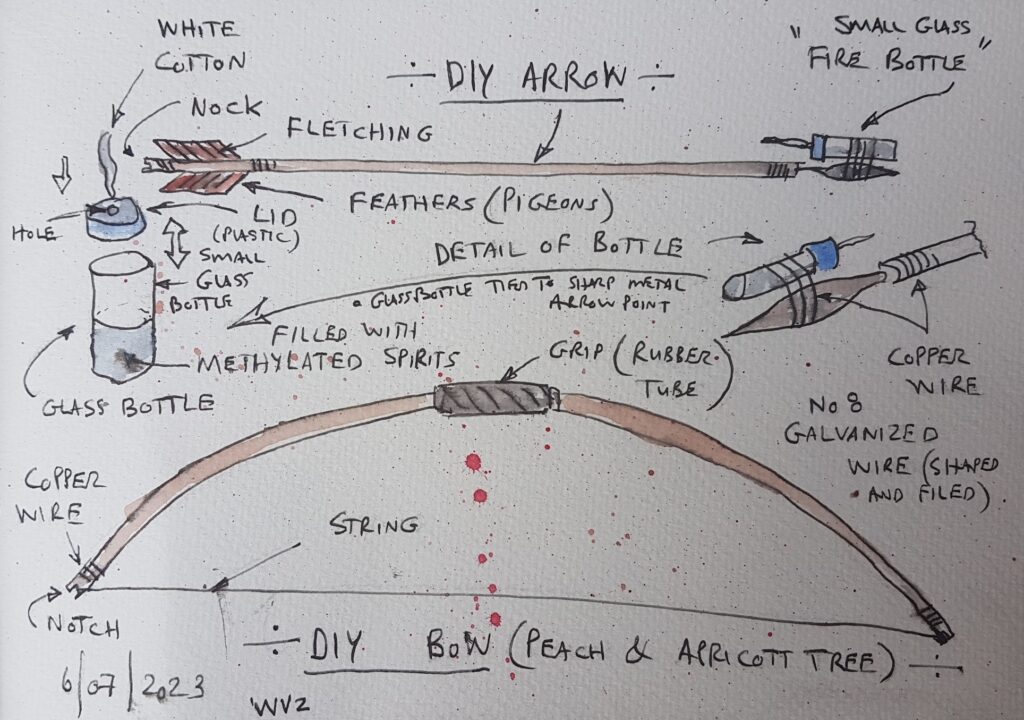
Bow and arrow illustration from my sketchbook (June 2023). See how the small glass bottle was attached with string to the sharp metal arrow point. The fiery arrow point would ‘explode’ in a ball of fire as the tiny glass bottle – filled with methylated spirits – shattered against the wooden fence.
Playing ‘Stretch’ – throwing and pegging a knife into the ground next to your competitor’s foot.
We also played the game ‘stretch.’ A simple game using a knife. Two persons stand 2 meters apart: Initially, both feet together. Taking turns, the blade was pegged into the lawn at short increments. The foot – closest to the pegged knife – was placed on the ‘marker’ where the knife was pegged. Then the other person would get a turn. The one who could not stretch to the knife’s position lost the match. The other person was declared the winner. I never had a mishap – I had some close calls. We had lots of fun.
More about my experiences as a young boy:
I had a fascinating and distinct upbringing. As you might assume, I was not travelling abroad but exploring our neighbourhood’s fields, bushes, tool sheds, and enigmatic underground passages and stormwater pipes. I still enjoy experimenting with concepts, science, and new possibilities. I frequently get new ideas while cycling, quickly capturing the unanticipated, distinctive, and creative on a page or drawing. I still have adventurous dreams of brutal battles and cutting-edge weapons in a young child’s scout cave. To this day, I constantly search for new enigmas to decode and encode. I am passionate about graphs, timelines, cross-sections, exploded views, detailed sketches, and communicating extravagant concepts and ideas.
I also love to investigate and explore extravagant thoughts and ideas, which I include in articles and stories. I love to have philosophical perspectives, alternative views, intriguing stories, and poetry in my writing. Academic and research work are also my forte. I always offer a simple but practical explanation within an engaging context. I am not your ordinary thinker – a lifelong scholar and teacher.
Army service in the RSA: I became a Paratrooper at 24.
My childhood – the exposure to air rifles, self-made handguns and rifles, the hideouts, the hunting of doves, and the secret troops we created – led to my interest in the army. In the 1980s, we had to do 2 years of military service (war against terrorism) in the republic and on the borders of Namibia (former South West Africa) and Angola.
Sketches of the hideout:
Sketch of the hideout (sectional view in 3-D). Pen, pencil, watercolour pencils. Credit: W Van Zyl (Nov 2018).
Inside the hideout. See the ‘hand gun’ constructed of timber. Powered by an elastic band. Based on a typical slingshot mechanism. William Van Zyl – November 2018.
Entrance to the hideout. A bin lid (metal) was used as the secret ‘door.’ The lid was covered with a thin layer of ground, and the grass was planted to conceal the entrance fully. William Van Zyl – Nov 2018.
Reflecting on the influence of an air rifle on me as a young boy:
As listed in this article, the benefits of enjoying a childhood with daily adventures – exploring hideouts, troops, air rifles, knives, bows, arrows, and dove hunting – significantly influenced my creativity, innovation, and technical skills. It also taught me respect for weapons, how to care for a firearm, finer adjustments on sights, gun maintenance, and the discipline to always apply health and safety rules.
I won the marksman badge (top score on the shooting range) in the South African Defense Force – SADF for the R4 and R1 rifles. All infantry soldiers with a significant shooting range score qualified for the first copper/brass badge. Those who excelled received the marksman badge (silver/chrome). See the marksman badge below. I wore the badge with much pride on my uniform.
R1 Assault Rifle (South African Defense Force – SADF). Open sights.1982.
R4 Assault Rifle (South African Defense Force – SADF). Open sights. 1983.
Silver RSA Marksman Proficiency badge (silver/chrome). Afrikaans: Skiet balkie. Source: https://www.bobshop.co.za/item/291284525/Silver_SA_Marksman_Proficiency_badge_Skiet_balkie.html

Beret 1 Parachute Battalion (Bloemfontein, Freestate, South Africa). Source: https://www.bobshop.co.za/item/177116650/SADF_1_PARA_parabat_beret_with_patch_badge_late_1980s_militaria_rarely_sold.html
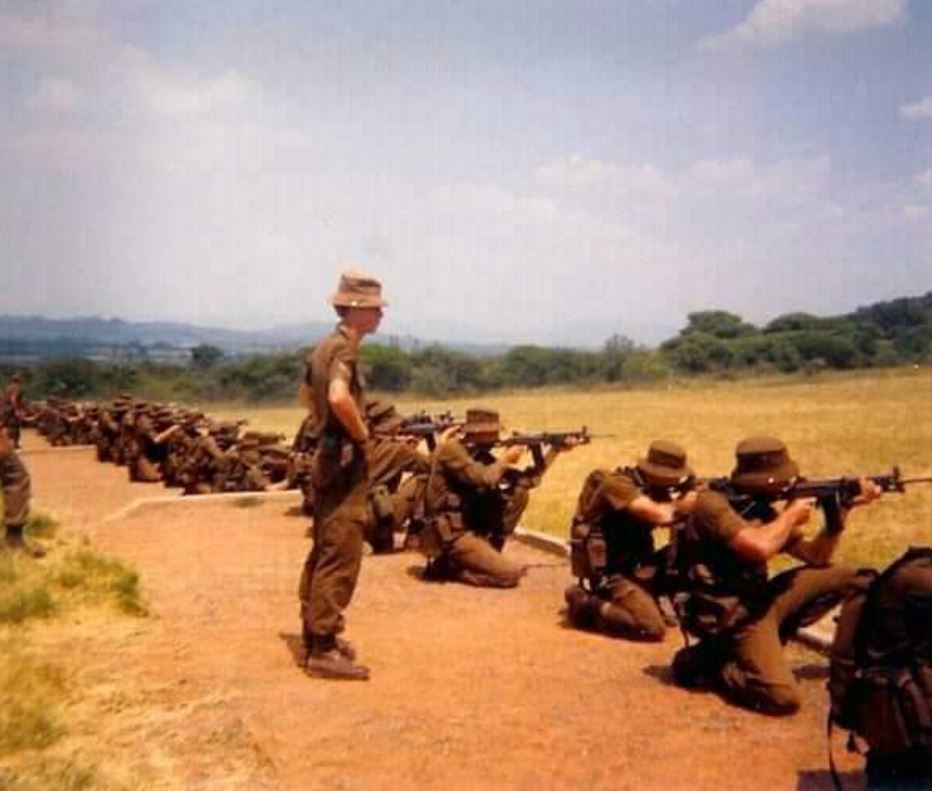
Infantry soldiers on the shooting range (Afrikaans – Skietbaan) SADF (South African Defense Force). ‘Kneeling position – fire.’ (‘knie-houding vuur.’) The corporal (standing) is managing the shooting session. (‘Oë op die front, op jou eie tyd, op jou eie teiken – vuur’). Credit: Mike the Warthog. @thyphoidjack
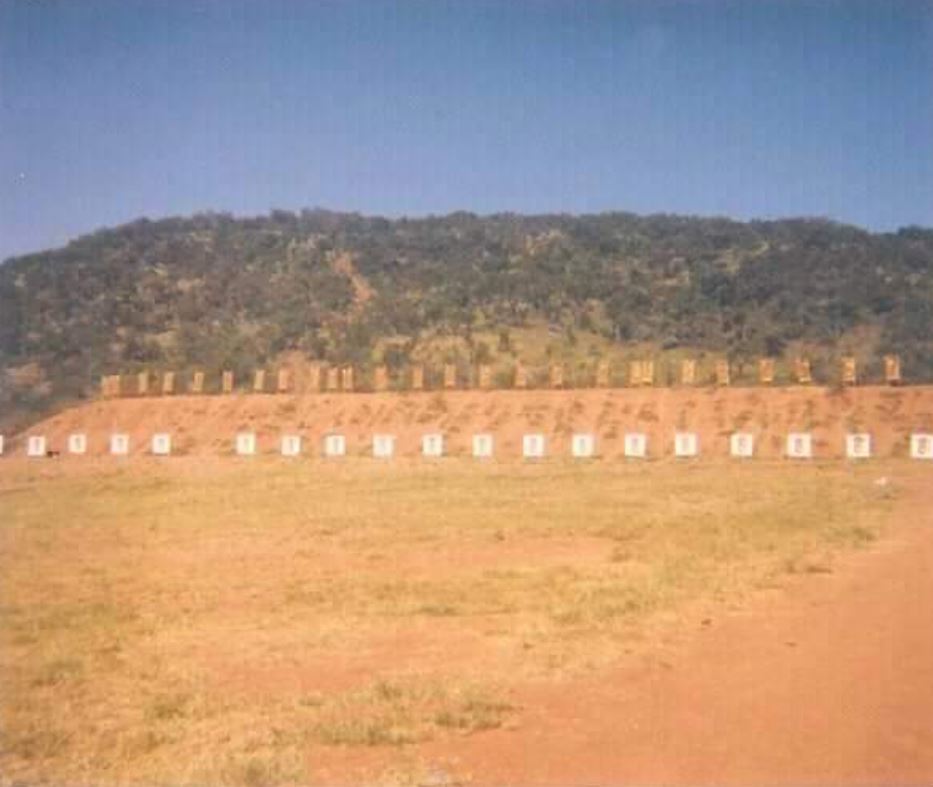
Targets at a distance on the shooting range. Targets in front, numbers of the targets at the far back. Soldiers take turns working behind the targets, pulling down the targets from time to time to place small round stickers over the bullet holes. Men make calculations at the targets producing the final scores of shooting sessions for each individual. A second corporal or sergeant manages the targets behind the scenes. SADF. Credit: Mike the Warthog. @thyphoidjack
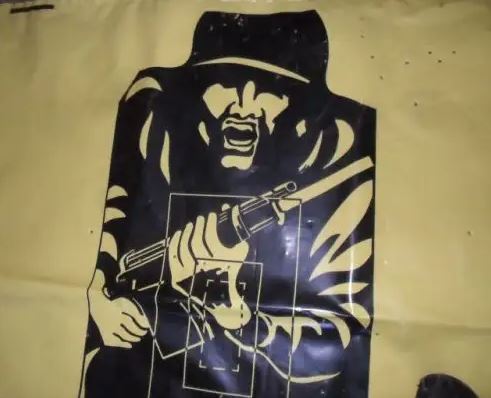
Close up of a target on the shooting range. These targets were used around 1982. SADF.
What were your experiences with air rifles, knives, bows, arrows, and other weapons when you were young? Did it play a significant role in shaping you as a person?
In this ethereal realm of air rifle training, young boys and girls can embark on a transformative journey that transcends the ordinary. Through the joys of marksmanship, they discover not only their own potential but also the wonders of history, the value of camaraderie, and the boundless lessons bestowed upon them by the sanctity of life.
Copyright © 2023 by William Van Zyl
A Pellet in my Mallet.
All rights reserved. This eBook/article or any portion
thereof may not be reproduced or used in any manner
without the publisher’s permission, except for using brief quotations in a book review.
Published by Five House Publishing (New Zealand)
First Publishing, June 2023
More eBooks and articles are available at https://fivehousepublishing.com/
More about the author at http://williamvanzyl.com/